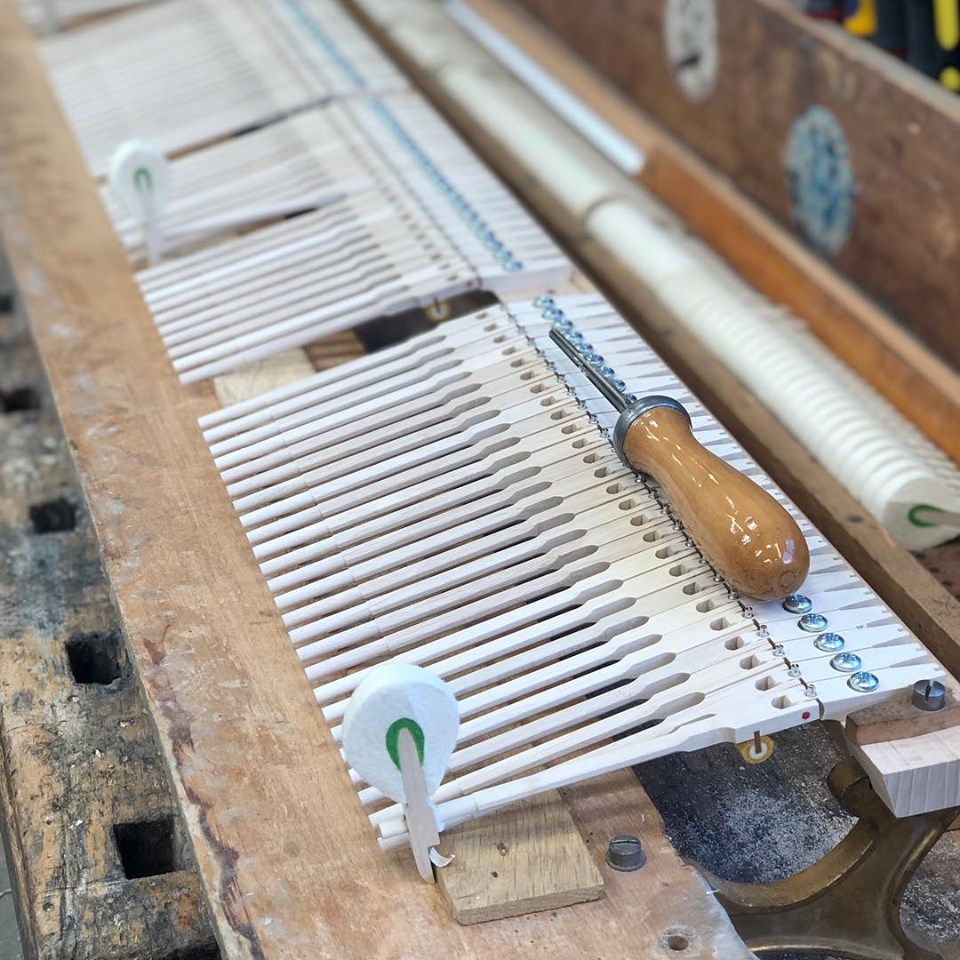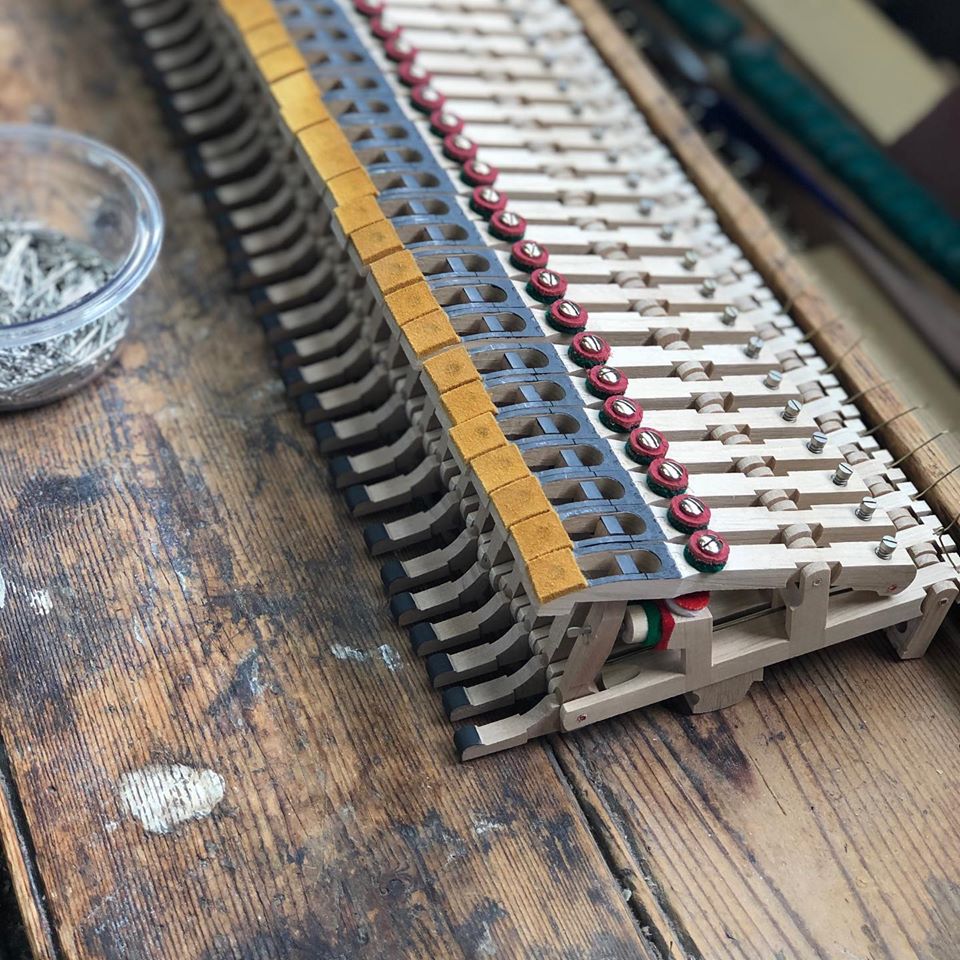If your piano is old, lifeless, sounding dull, or not holding the tuning, you may need a piano rebuild project. When a car gets old and tired, we rebuild it to extend its life. If we rebuild just the engine, it will likely run better. However, this does not address the aging brakes, bent tie rod, wheel alignment, or the many other items. If the wrest plate of a piano is replaced, the strings will hold their pitch better. However, this does not address the tired soundboard, bridges, worn hammers and wippens, crooked keys, and many other items.
Before we go any further, read about Artistic Style. It may help explain some questions before you dive into your first piano rebuild.
Rebuild Project
The top issue I hear from many of my clients is, “What will my piano sound like after it is rebuilt?” Looking brand new is important and we will make it look as good as new or better. We can include some modifications to make it your piano a one of a kind.
Playing Like A New One
Playing like a new one is important as well. Many instruments have had their action ignored and it starts showing in worn parts, bad action parameters (you can read regulation here), or consumable parts that have never been replaced. We will make your piano play up to its design potential. We can even alter some designs to make them play better.
Most Important
But the most issue we are asked about is, “Will my piano sound better?” The tone a piano involves its design. Was it intended to produce a big, round, ponderous sound? Or did it’s originator envision a lighter, brighter, jazz sound? Is it voiced for a 100 seat salon recital but sits in a 10,000 seat concert hall? Hammers, string tensions, rim size, soundboard thicknesses, room size, acoustics, and much more all will play a role in the tone produced by any given piano. We attack those items that give us the most influence over the sound but realize we can only point the sound in a direction. Beyond that, we will redesign your piano and make it sound the way you want. Just gives Campbell Piano Shop a call and we can start the process of giving you the piano you want to hear.
FAQs
These questions and answers are to start the rebuild process. They do not replace a discussion that sets specific goals for your project. They will, however, help you think about items you will want to consider.
1. What does it cost to rebuild a grand piano?
Rebuilding a grand piano is a labor-intensive process. We use the highest quality products and parts to insure consistent results. We spend in excess of 500 hours on the typical rebuild, not including refinishing. A new Steinway will range from thirty thousand dollars to over two hundred thirty thousand dollars. You can expect to pay approximately three-quarters of the cost of a new Steinway of the same size to have any grand piano rebuilt. Each piano is evaluated individually to determine the specific costs.
2. Why do prices vary so widely for ‘rebuilding’ a grand piano?
This is a great question and strikes at the heart of the quality of a rebuilder’s work.

Take a set of blueprints to ten contractors and you will get ten different estimates. Most of the price differences will be due to the quality of the materials and labor. Solid walnut cabinets, made and installed by master craftsmen cost more than pressboard substitutes put up by a day crew.
Piano rebuilders gain a reputation for the work they produce. A rebuilt grand piano should exhibit the following characteristics:
- A rich and full fortissimo. Not a crackling noise that is loud but has no body.
- A soft and luscious pianissimo. A soft sound should have a distinct quality, differing from a softer version of the loud sound.
- Great control. The musician should feel like they control the direction of the sound so as to express their musical tastes and thoughts.
- Impeccable finish. Nothing says ‘play me’ like a piano that looks ready to perform.
- Construction and design worthy of a world class instrument.
- A clear, warm piano tone that sings.
- A precise and even touch that supports a musician’s technique.
- A wide palate of tonal colors for full expression of a multitude of musical styles.
- A fine regulation of the parts so they work smoothly and consistently.
- A case that is aesthetically pleasing and structurally sound.
3. How long does it take to rebuild a grand piano?
Once a piano enters the shop, it will typically take six to eight months to complete. However, there are no guaranteed schedules for any project. The work continues until we are satisfied that the results meet or exceed the artistic goals. Each piano is unique and will require differing amounts of effort.
4. Is a rebuilt piano as good as a new one?
Rebuilt pianos have some distinct advantages over new ones.
- Customizable – A rebuilder makes strategic decisions that set the piano sound and playability more like you desire.
- Modernization – With the proper selection of materials and methods, an instrument can not only look better, but sound and play better for many more years.
- Cost savings – If executed well, a proper rebuild project produces a higher quality instrument for less money than purchasing a new instrument of similar quality.
- A rebuild project increases the market value of your piano.
5. Does Campbell Piano Shop change the design of an instrument during a rebuild?
There are two polar schools of thought regarding changing the design of a piano. One school says original design is flawless and should be followed to the letter. The opposite school says nothing is sacred and everything will have to be replaced and updated. I am guided by the goals of the project and not afraid to make alterations to a design. I am equally not afraid to stay with tradition when it brings the project closer to the goals.
Piano Rebuild Design
Piano manufacturers, even the most vaunted, have had issues with their designs, production lines, and/or quality control. Advances made in physics and the materials sciences make some of todays parts and methods far superior. However, wholesale changes often lead to a change in the character of the instrument.
We take inventory of the piano and evaluate each change in light of the artistic goals. No ‘throwing the baby out with the bath water’ with a new design. That said, we will not cling to history due to the name on the fallboard. If one of the goals is better action control, we redesign and build a new action.
This Old House
I watch home improvement shows like This Old House regularly. I am often puzzled by choices made when dealing with historically significant houses. On the one hand, plumbing, electrical, sewer, and many other household systems will not pass current building codes. To restore them to their original condition would render the building uninhabitable. To ignore the advances in efficiency and the material sciences to preserve the original design is counter productive. However, too much change puts the character of the house is at risk. We focus on the goals of a project without loosing site of the history and traditions of the piano.
Artistic Style
Campbell Piano Shop’s work is constantly evolving. Our services are of a unique and artistic nature. As such, the results may be different from other pianos we have rebuilt in the past. In addressing a piano, we use our personal artistic judgment to create a result consistent with our vision.

